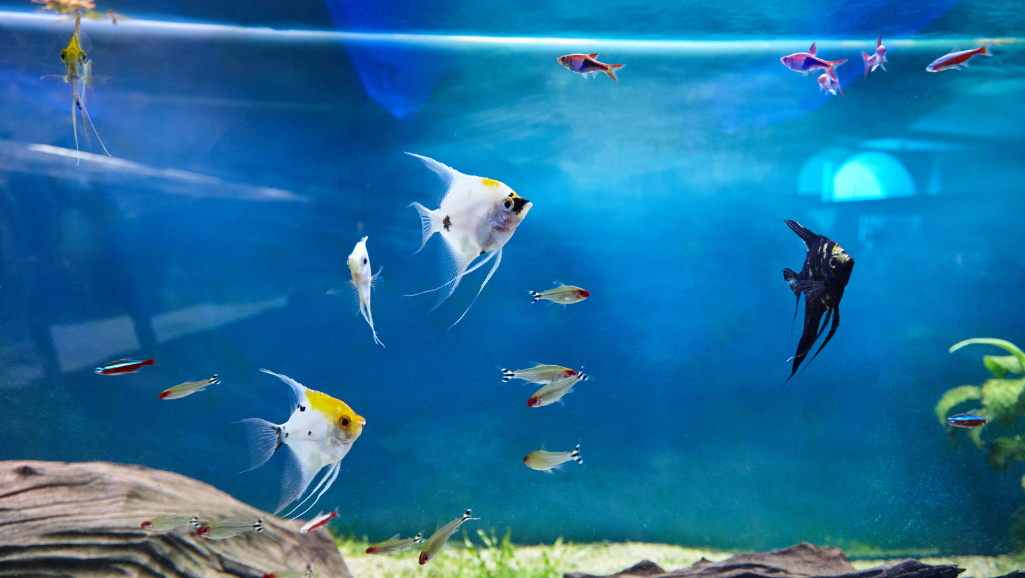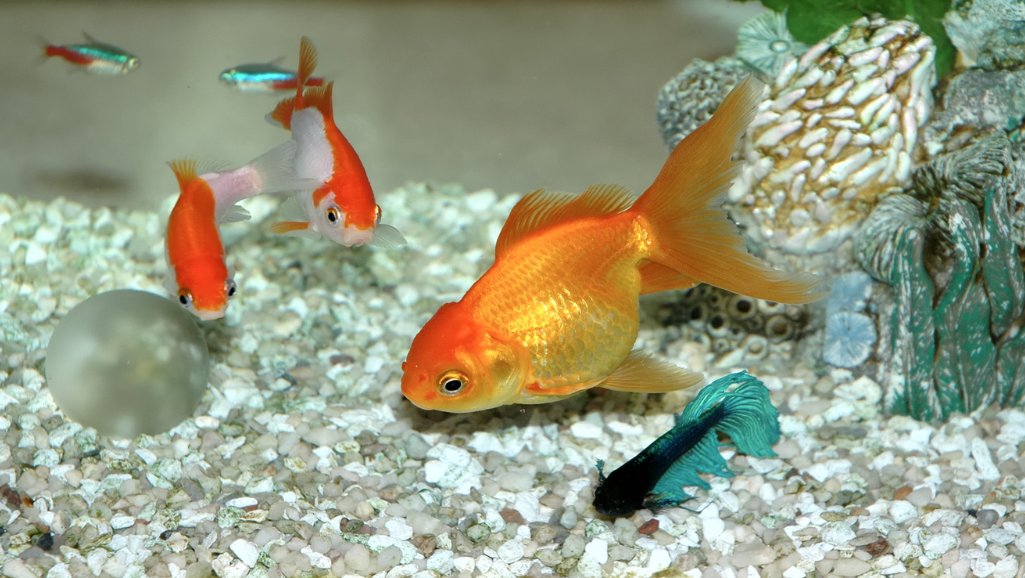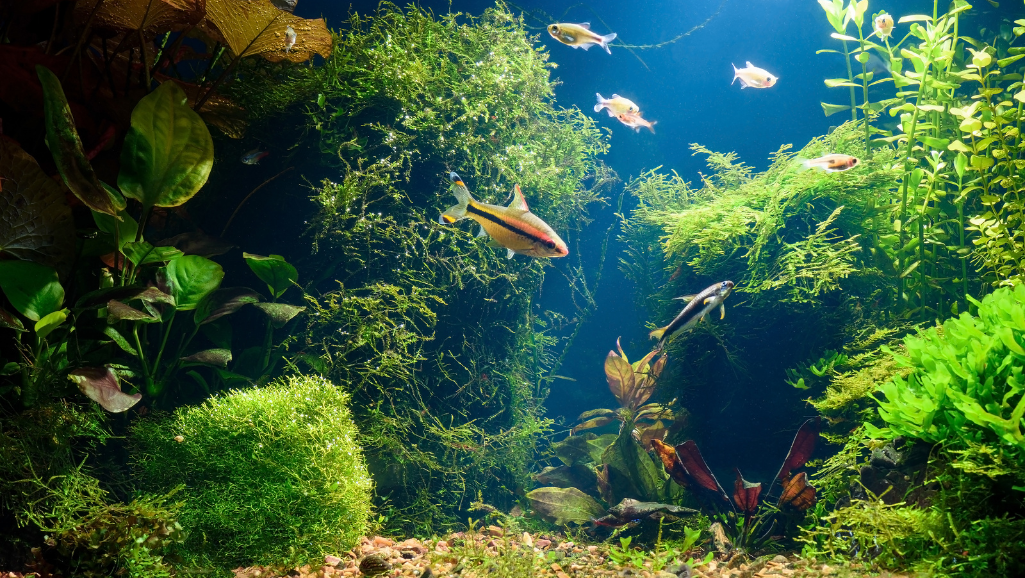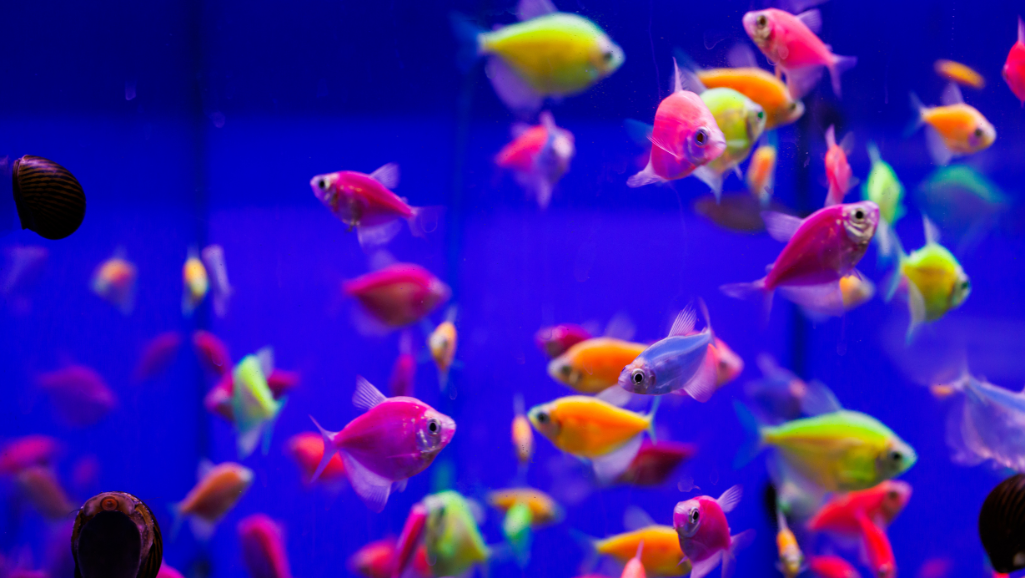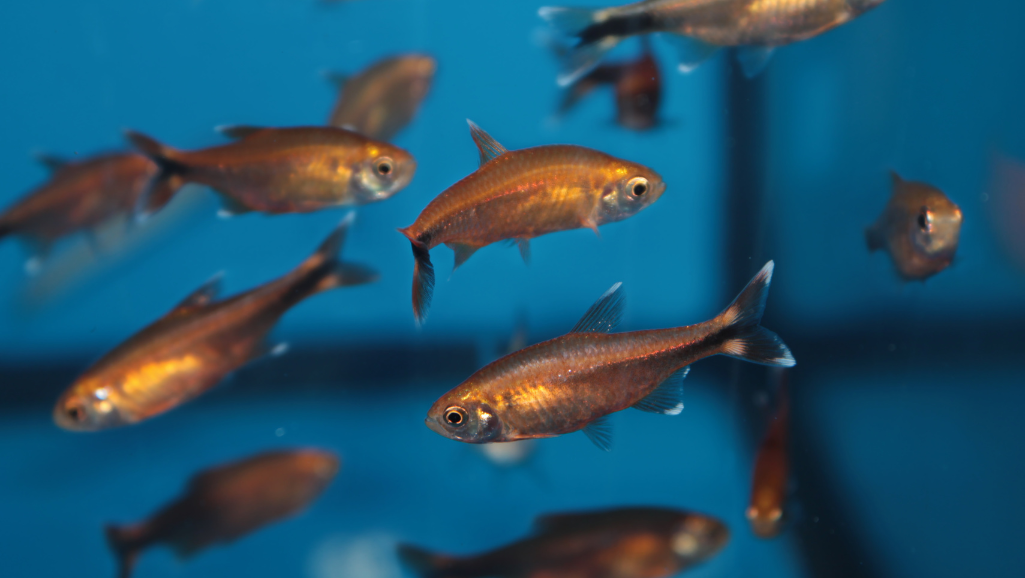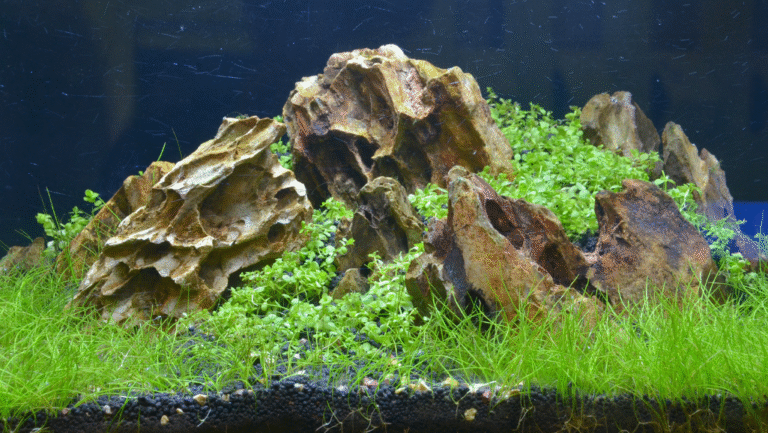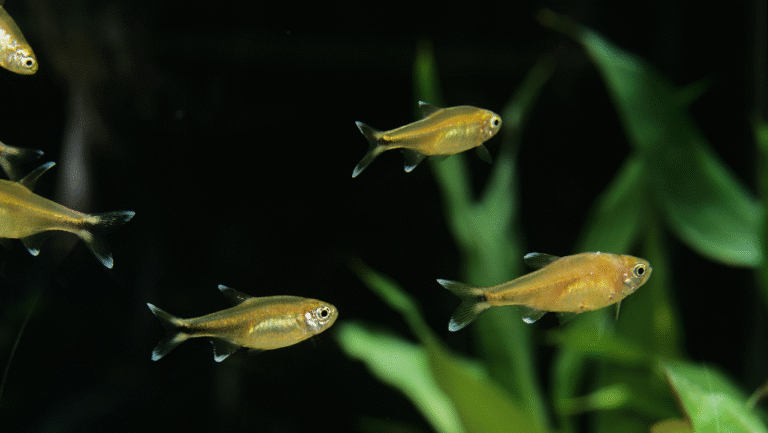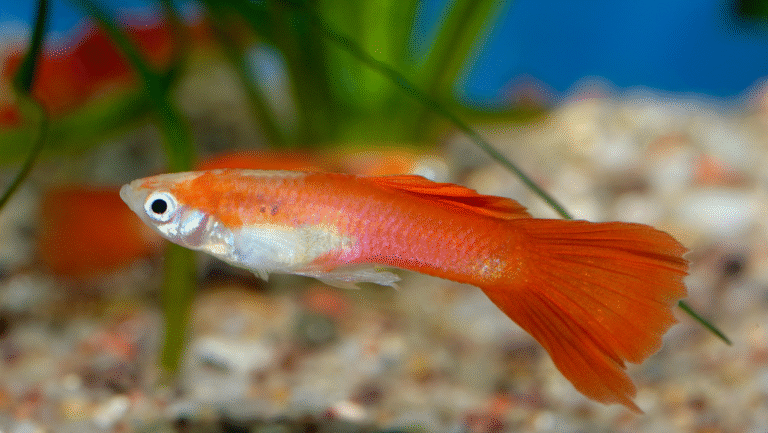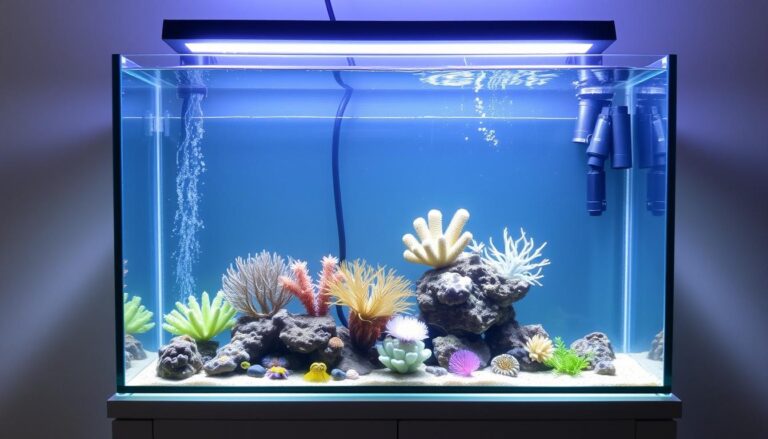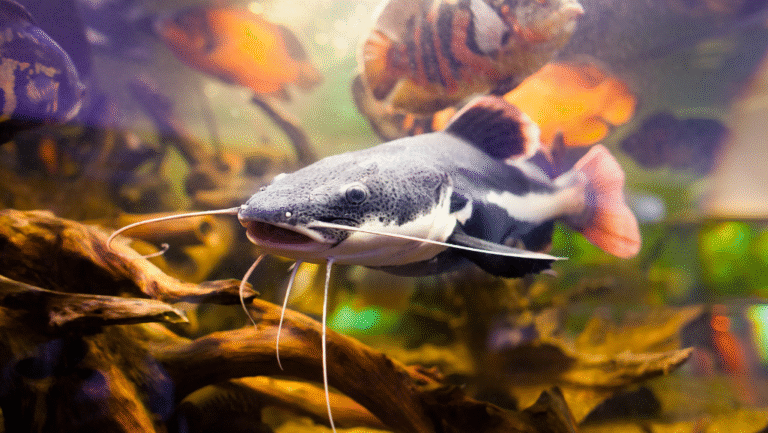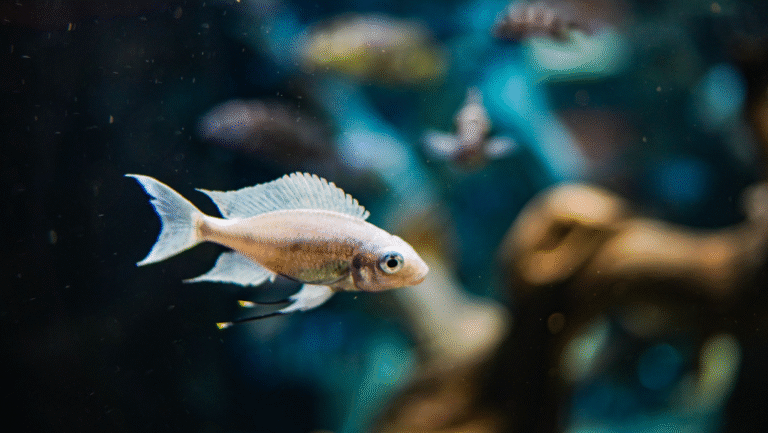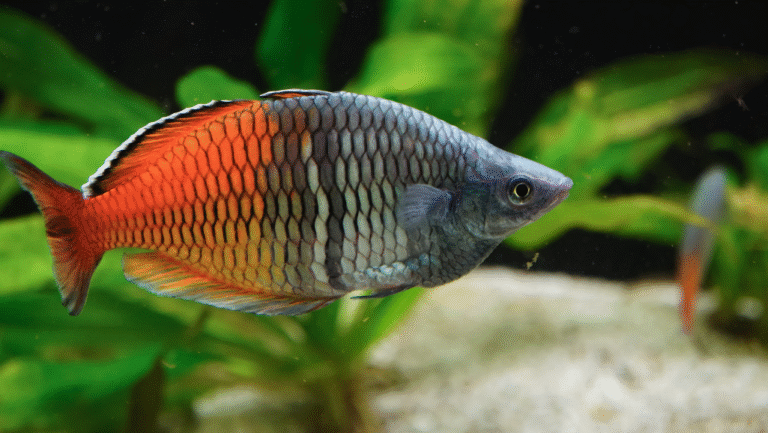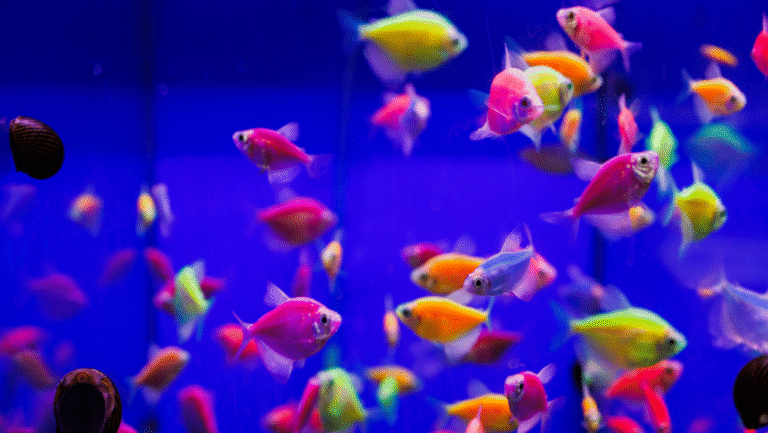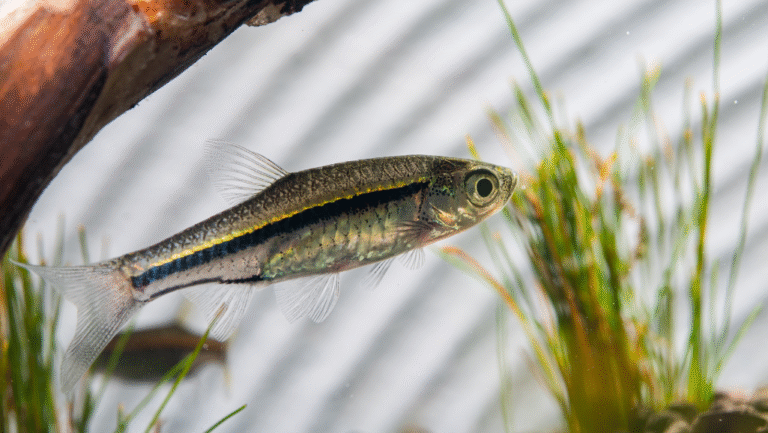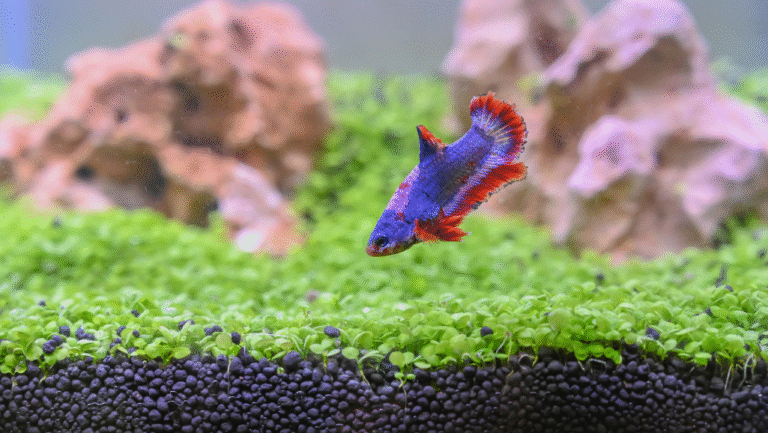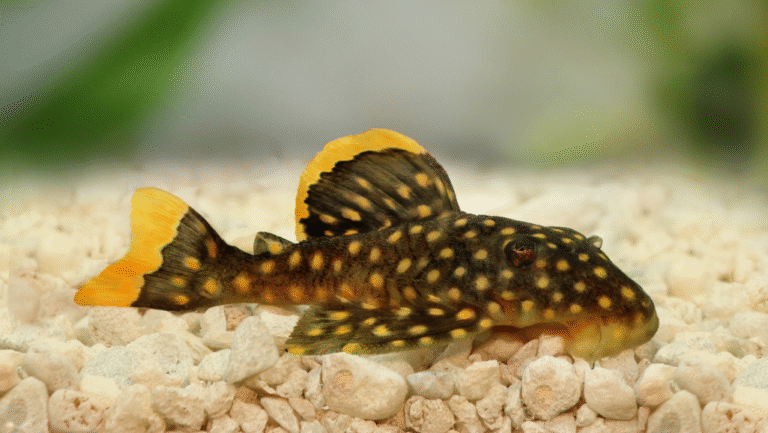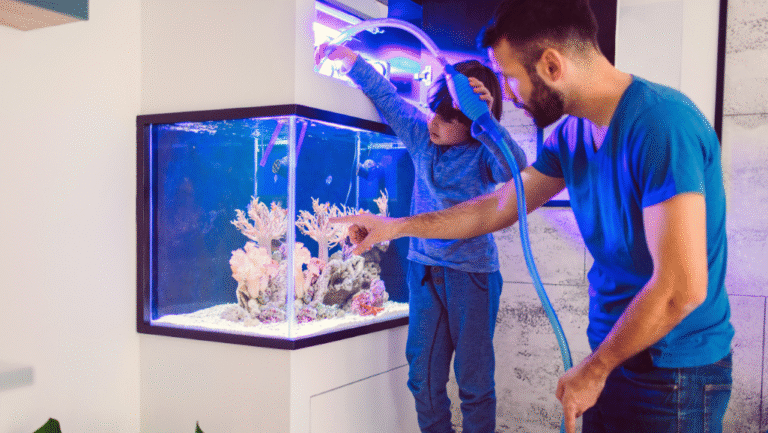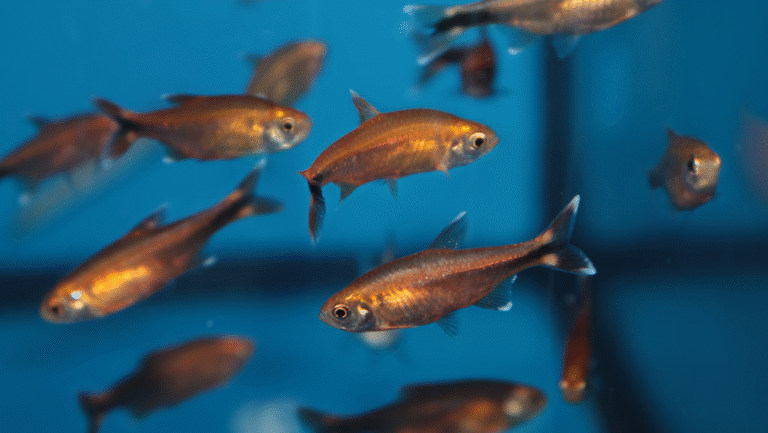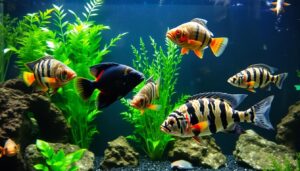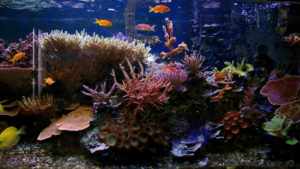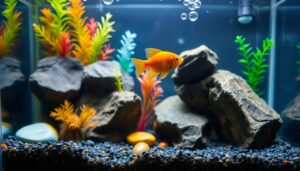Yes—certain small schooling fish can thrive alongside elegant angelfish if you match size, temperament, and habitat. Angelfish are graceful cichlids with narrow mouths, but they will eat tiny tank companions that fit. That makes thoughtful choice of species essential for a calm aquarium.
Warm, stable water and a tall tank help reduce stress for deep-bodied angels and allow midwater schooling species to keep distance. Dense plants and layered décor give smaller fish hiding spots and break direct sight lines.
Feed by levels so bigger fish do not dominate meals, and add bottom dwellers like Corydoras or bristlenose plecos to fill different niches. Make sure you size up tetras before mixing them in, and avoid known fin-nippers or coldwater species.
Key Takeaways
- Can Tetras Live with Angelfish.
- Right stocking and adult size let some tetras share a peaceful aquarium.
- Tall tanks, warm water, and gentle flow suit angelfish and reduce stress.
- Provide planting and layered décor so smaller fish find refuge.
- Feed at multiple levels so all fish get food.
- Avoid aggressive or tiny schooling species that may be eaten.
Quick Take: Building an Angelfish Community Tank with Schooling Fish
Prioritize warm, steady water and a tall tank for angels before introducing group-oriented midwater species. Aim for 78–84°F and pH 6.5–7.8, with gentle flow and plenty of vertical space. A 29-gallon tank suits a single pair, but 55+ gallons gives schooling dynamics room to breathe.
Choose community fish that stay midwater or bottom and form confident groups. Good partners include Corydoras catfish and bristlenose plecos below, and rosy, cardinal, or rummy nose tetras and praecox rainbowfish in the school.
- Stock schools in proper sizes (6–10+ individuals) so the group shows natural behavior.
- Feed floating, midwater, and sinking foods at the same time to reduce competition.
- Introduce newcomers after the scape matures and plants provide refuge for quick settling.
- Plan the layout to break sightlines and prevent chasing by curious angels.
- Commit time to watch the first weeks and adjust group sizes or layout as needed.
For a deeper list of compatible tank mates, check a curated guide on compatible tank mates for freshwater angels. Small parameter swings affect schooling cohesion, so make sure conditions stay stable.
Key Compatibility Factors Before You Mix Species
Start by sizing up adult specimens: whether a fish fits in another’s mouth is the quickest test for safety. Small, neon-sized choices face real risk of predation from larger cichlids.
Size and “What Fits in a Mouth” Rule
Prioritize adult sizes when planning a community. If a species can be swallowed, it becomes a snack-in-waiting.
Temperament, fin nippers, and schooling behavior
Evaluate behavior before adding any new stock. Some types nip fins or harass slow swimmers. Keep schooling fish in proper numbers so the group draws attention away from long-finned tank mates.
Parameters match: temperatures, flow, and water chemistry
Match preferred water ranges: 78–84°F and pH 6.5–7.8, and offer gentle flow. Spread food through the column so slow feeders and bottom dwellers eat too.
- Make sure tanks have height for deep-bodied fish.
- Plan cover and escape routes to break sight lines.
- Test water weekly to keep chemistry stable and stress low.
Black Skirt Tetras: The Tetra That Makes a Great Angelfish Tankmate
Black skirt tetras bring a sturdy midwater presence that blends well in tall community displays. Their broader bodies and calm temperament help them avoid becoming snacks, especially when kept as adults.
Why they avoid becoming snacks
Size and schooling save lives. A healthy school of skirt tetras creates visual mass and confidence, so adults rarely stray or lag. That makes them less tempting to curious angelfish.
Albino and GloFish varieties: color with caution
Albino and GloFish black skirt varieties add striking color to a tank. Introduce brighter morphs slowly, and provide plants and wood to soften sightlines.
“Choose adult specimens and a solid school to keep the group confident and safe.”
- Make great tank mates by matching flow and feeding fine granules that suspend in midwater.
- Pair them with bottom dwellers like Corydoras to complete a balanced community.
- Watch the first week closely and adjust if any individual becomes isolated.
For more compatible options and pairing tips check a practical guide on angelfish tank mates.
GloFish Tetras and Danios with Angels: What Works, What to Watch
GloFish morphs add striking color, but they change social dynamics in a community aquarium. Treat GloFish tetras as a color form of the black skirt and plan around their schooling needs. Undersized groups often spark fin nippers and chasing.
Keep larger schools and plenty of cover so the group moves confidently and distracts attention away from long fins. Plant mass, driftwood, and layered décor break sightlines and give refuge.
- Stocking tip: choose a larger tank and introduce angels last so established schools feel settled.
- Feed often in small portions and spread food by level to reduce competition and predation risk.
- GloFish danios usually work when kept as an energetic school that is too large to fit in an angel’s mouth.
- Avoid GloFish tiger barbs and rainbow sharks; their aggression harms tank mates and stresses the whole display.
“Watch for frayed fins or hesitant swimming—those signs mean adjust group size or add cover quickly.”
Over the first week, spend extra time observing cohesion. Rehome problem individuals early rather than let stress spread through the tank.
Other Schooling Fish that Make Great Visual Partners
If you want graceful activity at the water surface, adult pencilfish add elegance without crowding midwater lanes. These Nannostomus species patrol the top zone and bring subtle motion that contrasts larger, slower swimmers.
Pencilfish for the top layer: elegant, adult-sized additions
Choose adults so they are not bite-sized. Pencilfish hold their own in size and prefer calm surface currents. Add floating plants or shaded zones to help them feel secure.
Praecox rainbowfish for sparkle without stress
Praecox rainbowfish add vivid shimmer and responsive schooling behavior. They need excellent water quality and do best in groups of six or more to show true color and confidence.
- Elevate the top zone with adult pencilfish to keep midwater lanes open.
- Keep rainbowfish in 6+ groups so they school boldly and avoid crowding angelfish midwater paths.
- Match gentle flow and warm conditions so both species settle quickly and feed actively.
“Layered movement gives an aquarium depth, letting each species showcase its motion and color.”
Bottom Dwellers that Balance the Tank
A calm lower layer brings balance to a busy community aquarium. Thoughtful bottom dwellers add motion and clean-up duty without stirring trouble among midwater species.
Corydoras catfish: armored, peaceful, and perfect for sand bottoms
Corydoras are ideal community catfish that sift sand gently and charm observers all day. Choose adult specimens and avoid tiny dwarf species to reduce risk of injury or predation.
Make sure the substrate is soft sand to protect barbels and to let Corydoras forage naturally. Acclimate slowly to guard delicate gills.
Bristlenose plecos and other small plecos: algae patrol without crowding
Bristlenose and compact plecos (clown, L333, snowball) handle algae and biofilm without overwhelming an angelfish tank. Provide driftwood, caves, and leaf litter so nocturnal plecos have shaded rest areas.
- Fill the lower level with peaceful fish that add charm and zero drama to your tank.
- Choose small pleco species over giants like sailfin or common plecos.
- Feed sinking wafers at lights-out and maintain wood for natural rasping behavior.
“A thoughtful bottom crew keeps the aquarium healthy and the angelfish comfortable.”
Rummy Nose, Cardinal, and Neon Tetras: Proceed Carefully
Dense aquascapes and large shoals help tiny fish hold their ground in a tank shared with bigger, curious cichlids.
Rummy nose tetras do best in groups of 10 or more and need pristine water to stay tight and confident. In well-planted aquariums their bright red noses are bold and steady.
Cardinal tetras are peaceful but remain small enough to be risky around larger angels. Neon-sized tetra are the most vulnerable and require extra cover or adult purchases.
- Treat neon-sized fish with caution; predators may view them as food in sparse layouts.
- Make sure you buy near-adult sizes and introduce them into a mature, heavily planted tank.
- Feed small, frequent midwater foods so tiny mouths aren’t outcompeted.
- Increase school sizes to diffuse risk and reduce isolation.
- Use darker substrate and leaf litter to reduce glare and help shy shoals relax.
“If losses occur, reassess quickly and consider sturdier-bodied species like the black skirt.”
Species to Skip: Fin Nippers and Mismatched Tankmates
Not every popular aquarium choice belongs in a peaceful angelfish display. Some species bring chasing, fin damage, or opposite water needs that harm the whole tank. Choose safety over novelty so your gallery remains calm and graceful.
Watch out for habitual troublemakers. Tiger barbs and serpae tetras are notorious fin nippers that shred flowing fins and stress slower swimmers. Bettas fare poorly in lively flow because their long fins invite harassment and conflict.
Goldfish belong in cool systems, not warm tall tanks favored by angels. Likewise, many Rift Lake cichlids and silver dollars are too aggressive or hyperactive to pair safely with calm, measured swimmers.
- Skip tiger barbs and serpae tetras—they target fins and unsettle schools.
- Avoid bettas and cold-water goldfish due to fin vulnerability and mismatched temperatures.
- Steer clear of large predators and monster fish (oscars, piranhas, arowanas) that turn peace into risk.
- Question “peaceful” labels—some mild cichlids can escalate in tight quarters.
“If a species brings speed, chaos, or a different temperature range, it’s not worth the risk.”
Prioritize proper tank mates and rehome any problem animals early. Your angels’ health and the display’s harmony depend on careful choices.
Stocking Strategy and Tank Size for a Peaceful Angelfish Community
Design your stocking plan around height and swim lanes so every species has room to express natural behavior.
Choose a large tank that favors vertical space. A single pair can survive in 29 gallons, but an angelfish community tank performs best at 55+ gallons. Tall tanks match the deep bodies of angels and stabilize social dynamics.
Why height and footprint matter
Vertical room gives angelfish freedom to glide and reduces confrontation. It also creates clear midwater lanes for schools.
Layering the water column: top, mid, and bottom dwellers
Map your layers deliberately. Top residents like pencilfish or hatchetfish patrol the surface. Midwater schools—small tetras or rainbowfish—bring motion. Bottom dwellers such as Corydoras and small plecos clean and calm the substrate.
- Stock schools in proper sizes and space them across the column so no group feels cornered.
- Use canister or HOB filtration with adjustable outlets to create gentle flow that favors both angels and midwater fish.
- Build a plant-rich scape to break sightlines; this is the best way to reduce chasing and offer secure retreats.
- Make sure you don’t overpack midwater—leave sweeping lanes for angelfish to move freely.
“Start modestly and scale schools as harmony settles; a small change in layout often calms the whole tank.”
Feeding and Maintenance: The Simple Way to Reduce Competition
Offer floating, midwater, and sinking rations at once to reduce scramble and protect smaller mouths.
Plan meals by level so top swimmers, middle schoolers, and bottom cleaners all eat. Feed floaters for surface species, fine granules for midwater fish, and sinking wafers for bottom dwellers such as catfish.
Make sure portions are modest and served frequently. Small, repeated feeds stop assertive fish from hoarding and help shy tank mates get food.
- Keep water pristine: aim for ammonia and nitrite at zero and nitrates under ~30 ppm.
- Change schedule: perform partial water changes 2–4 times per month and vacuum quiet corners.
- Filter care: rinse mechanical media in tank water and clean on a set schedule to protect beneficial bacteria.
- Target-feed hesitant individuals with a pipette and rotate staples like Bug Bites with frozen treats.
Gentle flow and oxygen-rich water calm competitive eaters and improve color. Bottom feeders and otos need sinking diets and mature algae to thrive in a mixed community.
“Balanced feeding and steady maintenance keep stress low and help every species flourish.”
can tetras live with angelfish: A Step-by-Step Plan to Introduce Tankmates
Start introductions slowly and thoughtfully to protect your angelfish community. New arrivals should spend time in quarantine in a small, heated, filtered tank to prevent disease. This step saves stress and keeps established stock healthy.
Quarantine, introduce adults, and monitor behavior over time
Choose near-adult sizes for small school fish so the group stays confident. Introduce that group first, then add angels last. This sequencing reframes newcomers as neighbors rather than prey.
Have a backup tank ready for surprises
- Make sure a backup tank is set up for quick separation if tank mates clash.
- Rearrange décor before introductions to reset territories and give every fish fair space.
- Feed smaller, frequent meals and dim lights during the first days to lower tension.
Observe closely over the first hours, days, and two weeks. Balance angel sexes and consider fast dither fish if a pair grows edgy. Keep notes on behavior and feeding; that way decisions about stocking or layout are informed and calm.
Conclusion
A large aquarium that blends calm midwater schooling, stable temperatures, and quiet bottom dwellers often yields the best results.
Choose hardy species like black skirt tetras, pencilfish, Corydoras, and bristlenose plecos to make great neighbors in a tall, planted tank. Praecox rainbowfish and rummy nose tetras work when kept in proper groups and pristine water.
Aim for a 55+ gallon setup, 78–84°F, and gentle flow. Keep adult sizes, correct school numbers, and roomy swim lanes so natural behavior shines.
Avoid chronic fin-nippers such as tiger barbs, serpae, rowdy cichlids, bettas, and goldfish. Patient introductions, steady maintenance, and thoughtful stocking turn a group of species into living art.
